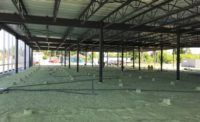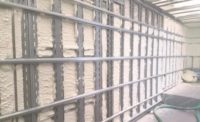Spray Foam’s Hurricane, Flood & Wind Resistance Performance in Commercial Facilities

The increasing number and intensity of hurricanes and storms in the United States is not only cause for general safety concern but is top-of-mind for builders, contractors and facility owners who have witnessed the damage that may be incurred to commercial structures. Stanford University researchers recently attributed a $75 billion price tag specifically to the flood damage incurred in the U.S. over the past three decades, caused by intensifying rainfall driven by climate change. Another report by reinsurance company Munich Re determined that in 2020 the world’s six most expensive disasters occurred in the U.S., the worst of which was Hurricane Laura.
Commercial facilities are in fact vulnerable to serious storms and inclement weather. First Street Foundation, the non-profit research and technology group, asserts that more than 14 million properties across the Unites States are susceptible to flood damage. Luckily building material innovations have resulted in options that, when applied properly, can assist in protecting commercial facilities from the severe weather events bound to grow in frequency. Closed cell spray polyurethane foam (SPF) is one such material. When applied in walls, ceilings, floors and on the roof, closed cell SPF protects the structure from serious, costly damage.
Water Resistive Barrier & Flood Resistance
Closed cell spray foam is ideal for continuous insulation applications in commercial structures and can be used in both interior and exterior applications where it can essentially replace commonly utilized rigid XPS and PIR foam boards. The material boasts low water absorption as well as resistance to mold, as demonstrated with ASTM C1338. Closed cell spray foam excels as a water resistive barrier on exterior applications and is tested in accordance with ASTM E2357 with a pressure up to 300 Pa for Air Barrier Assemblies which included the ASTM E331 (AC71) Water Penetration Testing. The result was no leakage through the spray foam.
When applied in walls, ceilings and floors, FEMA names it a Class 5 material, the highest classification for products indicating strong resistant to floodwater damage. Class 5 materials do not require special waterproofing protection, can survive wetting and drying and may be successfully cleaned after a flood to render them free of most harmful pollutants. As a Class 5 solution, closed cell spray foam provides both time and money savings for owners of commercial structures which have endured flood conditions. Additionally, while closed cell spray polyurethane foam may be applied as cavity insulation or as continuous insulation in commercial structures and still qualify as a Class 5 material, it does happen to be the only cavity insulation approved by FEMA with this highest floodwater resistance. When applied under slab as insulation, closed cell spray foam is also flood resistant.
Structural Strength and Wind Resistance
The application of closed cell spray polyurethane foam in above grade walls can also increase the structural strength of buildings and assist with wind resistance. The degree of hardening depends primarily on the strength of the building to begin with. For example, an I-beam modular constructed metal building with a 22-gauge metal panel will benefit significantly less from an interior application of closed cell spray polyurethane foam than a post-frame constructed building with 29-gauge corrugated metal panels will. When installed, closed cell SPF essentially glues the assembly together, reduces the potential for movement and adds a tensile strength average ranging from 15 psi to 25 psi.
The Spray Polyurethane Foam Alliance conducted racking performance tests in 1992 and 1996 and at Architectural Testing, Inc. in York, PA in 2007 demonstrating that medium density closed cell SPF, installed at 2.0 pounds per cubic foot, increases racking strength by 70% to 200% in wall assemblies sheathed with oriented strand board (OSB), plywood, gypsum wallboard, vinyl siding and polyiso board. The research proved closed cell SPF significantly increased rack and shear strength in both wood and metal construction. Installed SPF also increases the strength of weaker substrates such as gypsum drywall, vinyl siding and polyiso foam insulation at a much greater percentage than stronger substrates such as OSB and plywood. Notably, special bracing for wind resistance is not required for strengthening purposes when using closed cell spray foam in walls.
Roofing & Wind Uplift
Spray polyurethane foam roofing, a denser closed cell option at around 2.8 pounds, is also an ideal solution for commercial structures located in hurricane prone regions such as the Southeast, Gulf Coast and Puerto Rico. The material’s adhesion qualities make it particularly ideal where severe weather cycling, storms, wind, hail and other conditions frequently cause damage. As a roofing material, spray foam forms a durable, monolithic membrane over the roof and offers a compressive strength of approximately 40 to 55 pounds per square inch. It also changes little with time and, when properly maintained, lasts 30 years or more.
Spray foam roofing increases wind uplift resistance when installed to the roof substrate and, when applied to concrete, wind uplift protection is even stronger. The material also resists peeling failure, which is a result of wind pulling flashings and copings away from a roof’s edges, which can ultimately lead to devastating damage to the structure.
Some high-performance spray foams demonstrate wind uplift resistance by meeting the High Velocity Hurricane Zone (HVHZ) criteria of the Florida Building Code. Notably, the material’s ability to withstand leaks due to hail is also unsurpassed.
The National Institute of Standards and Technology reviewed roof damage following Hurricane Katrina and discovered that buildings roofed with spray foam performed well without blow-off of the SPF or damage to flashings. The 2006 report found only one of the examined SPF roofs incurred notable damage and concluded that spray foam kept the roofs intact, prevented moisture from entering the buildings, and protected the structures from hail and debris.
References
- CNBC, Climate Change has Cost the U.S. Billions of Dollars in Flood Damage, Study Finds, https://www.cnbc.com/2021/01/11/climate-change-has-cost-the-us-billions-of-dollars-in-flood-damage.html
- First Street Foundation, The First National Flood Risk Assessment: Defining America’s Growing Risk, http://assets.firststreet.org/uploads/2020/06/first_street_foundation__first_national_flood_risk_assessment.pdf
- FEMA, Flood Damage-Resistant Materials Requirements for Buildings Located in Special Flood Hazard Areas in Accordance with the National Flood Insurance Program, Technical Bulletin 2, August 2008
- Honeywell, Insulation and Waterproofing for Metal Buildings and Metal Roof Systems: The Case for Using Better Insulation and Waterproofing Technologies in Metal Roof Systems and Metal Buildings
- Architectural Testing, Performance Test Report Rendered to Spray Polyurethane Foam Alliance, Project: Racking Load Tests, 2007.
- National Institute of Standards and Technology, Performance of Physical Structures in Hurricane Katrina and Hurricane Rita: A Reconnaissance Report, 2006
Looking for a reprint of this article?
From high-res PDFs to custom plaques, order your copy today!





